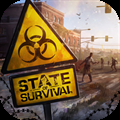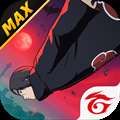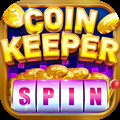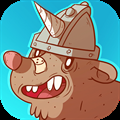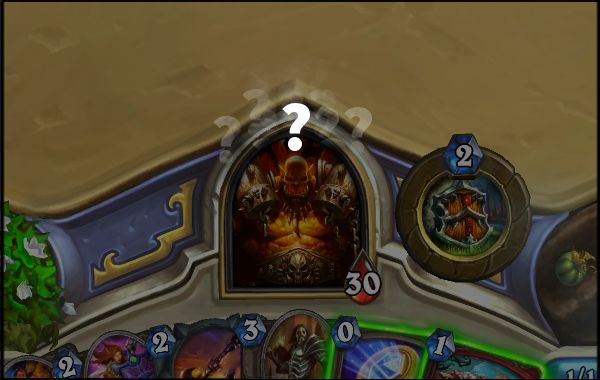
Wanna blow something up?
In the world of E-sports, luck can be a dirty word. When it’s not being thrown around as an insult, luck is used to discredit unlikely victories and explain embarrassing losses. Where as the concept of skill is revered and respected, luck is something we try to keep out of the tournament scene as much as possible. Pro players use superior technical execution and strategic thinking to win consistently, prevailing despite of bad luck. This is what every E-sports fan strives for, which is why being called lucky is such an insult. No one should rely on “just” luck to win.
If you are reading this, than you already understand why Hearthstone is, and always will be, a game centered on chance and luck. Card games are notorious for simultaneously offering a deeply competitive experience alongside an inherently luck centered game and Hearthstone is no different. Despite all the strategy and planning, sometimes an almost surefire victory can turn into a defeat, thanks to your opponent having that one perfect card on the top of their deck.
A skilled player can lower the chance of blowout scenarios by altering their play and keeping cognizant of dangerous "what if" scenarios.
Without even mentioning the large portion of cards that are designed to be RNG centered, (Well met to you too, [card]Ragnaros the Firelord[/card]) Hearthstone games are sometimes decided on luck alone. A fun exercise to illustrate this is to imagine a game of Hearthstone in which one player has a direct answer to every single card their opponent has the misfortune of playing. This game begins by the unlucky player playing a [card]Dust Devil[/card], only to have it killed by an opposing [card]Elven Archer[/card]. This goes on for the rest of the game, and the unlucky players [card]Murloc Tidehunter[/card] is met with two [card]Hungry Crab[/card]s, their [card]Gurubashi Berserker[/card] gets eaten by a [card]Stampeding Kodo[/card], and the game is usually over by now.
Not many other games can create situations so unwinnable, but in Hearthstone it is possible. These type of scenarios happen all the time, and, all it takes is two or three consecutive turns of poor luck to permanently shift momentum out of your favor. Thankfully, with some foresight (Not [card]Far Sight[/card], I wish this card was playable) a skilled player can lower the chance of such blowout scenarios by altering their play and keeping cognizant of dangerous “what if” scenarios. While Hearthstone is a game that’s gameplay relies heavily on luck, you don’t have to!
My eyes are open.
If you don’t play around cards your opponent might have, you need to start doing so. Like, immediately. Any other style of play leaves you hopelessly susceptible to any number of terrible things your opponent might do to your poor minions. If you aren’t actively playing around cards each turn, than Hearthstone becomes a game of pure chance: each defeat summed up to bad luck or some other variation of “If only they didn’t play X card”.
If you aren’t actively playing around cards each turn, than Hearthstone becomes a game of pure chance.
To clarify, playing around a card is when, out of fear of being put at a severe disadvantage, you assume your opponent has the exact card that would ruin your day. Using this assumption, you decide your sequence of plays with the hopes of minimizing or even completely negating the effectiveness of the card you initially feared. Again we do this in Hearthstone to minimize the consequence of our opponent getting lucky.
Successful Hearthstone players love playing around powerful cards, as the benefits of not immediately losing the game far outweigh any of the small sacrifices to board presence or pressure that might have been made in order to dodge the blowout. Some card games favor extreme methods of playing around certain cards, but this is much less effective in Hearthstone. The best we can hope for is to minimize the negative outcome, as it is for the most part, eventual two for ones are inevitable.
Playing around cards generally looks something like this.
Scenario A: I am afraid my opponent might have a spell next turn that kills my minions before I can accrue value from them. I will instead play a minion that yields value immediately, or only a few minions that I don’t mind losing.
Example: Instead of running your [card]Ragnaros The Firelord[/card] straight into an [card]Execute[/card], you might instead play other minions that need to be dealt with, like [card]Druid of the Claw[/card] and [card]Harvest Golem[/card]. That same 8 mana investment is much less punishable by [card]Execute[/card], and allows you to play [card]Ragnaros The Firelord[/card] next turn with a certain degree of safety.
Scenario B: I am afraid my opponent has a mass removal spells that will kill all of my minions next turn. Based on this assumption, I will not play multiple minions that can be killed by this spell the turn before my opponent has the mana to use it.
Example: [card]Consecration[/card] is the most powerful on turn four, as the minions played on turns one through three all have around two to three health. If your paladin opponent is about to enter turn their four, playing double [card]Flame Imp[/card] and a [card]Dire Wolf Alpha[/card] on your own turn four is needlessly risky. Any other turn four play is preferable.
Scenario C: Based on my life total and my opponents class and deck, I am afraid my opponent can kill me next turn. With this in mind, I will assume my encroaching death and focus on minimizing as much damage as possible this turn, effectively eliminating this small, but possible scenario.
Example: Against miracle rogue, the average amount of burst damage possible using only two cards is around 10-14 damage. If you find yourself at 10 HP, your priority should be getting above that threshold. Saving five mana to Armor Up and [card]Shield Block[/card] can be the difference between victory and defeat.
Scenario D: I am afraid my opponent will play a powerful minion next turn that outclasses my current board. With this in mind I will save my removal spell until I can use it on a minion I couldn’t otherwise kill with my own minions.
Example: If your opponent has a [card]Sunwalker[/card] in play, and you suspect they also have a [card]Tirion Fordring[/card], it may be worth saving your [card]Ironbeak Owl[/card] for the latter. Minions can deal with [card]Sunwalker[/card] by attacking, but the deathrattle on Tirion can win the game on the spot. In general, saving your removal spells for the absolute most powerful thing your opponent has is a good idea.
There are many other nuanced scenarios, but these are the most common. By taking these situations into consideration, you are effectively managing the risk your opponent represents. It may be challenging to start thinking in constant “what if “ scenarios, but the more you do so, the easier it becomes.
Knowing all of the cards in the game makes this a lot easier, but you can start off just by remembering the specific class spells and minions and their mana cost.
Extra attention should be placed on mana cost, as due to incremental mana system in Hearthstone, a card's mana cost allows you to essential predict the time it will be played. For example. It does no good to play around [card]Holy Nova[/card] on turns one through four, as [card]Holy Nova[/card] cost five mana. It essentially doesn’t matter whether or not it is in your opponent’s hand, as they can not use it. Play as many two-health minions as you can during these turns, as you will most likely be able to gain value from them, even if a [card]Holy Nova[/card] eventually kills them.
Extra attention should be placed on mana cost, as due to incremental mana system in Hearthstone, a card's mana cost allows you to essentially predict the time it will be played.
However, you can bet when your opponent does have 5 mana, a [card]Holy Nova[/card] will be coming your way. In this scenario, playing minions that will die, or be made vulnerable to low value minion trades to a [card]Holy Nova[/card] before they can attack or otherwise gain value is generally a bad idea. If you have other plays that are just as passable and stronger against [card]Holy Nova[/card], you should take those instead.
Of course …
In the above examples you can notice a similar trend. Playing around cards can be divided into roughly two categories: Dodging removal spells and forcing suboptimal plays. Depending on your decks archetype and win conditions, you will find yourself more concerned with one over the other, but both should be considered at every turn.
Faster aggro decks are mainly concerned with finding the perfect balance between a threatening board position and remaining resilient against mass removal. Minions should be played in sequences that maintain board pressure and keep a ready supply of threats in hand once the inevitable removal spell drops.
Slower control decks on the other hand, need to allocate their threats in order to exhaust their opponents single target unconditional removal, paving the way for their legendary finishers. A good control player will tactfully flood the board with [card]Sludge Belcher[/card], [card]Harvest Golem[/card], [card]Sunwalker[/card]s, and other sticky minions in the most difficult sequence that takes the most removal spells and minions to counter.
What about Arena?
Naturally, the priority and manner in which you play around cards in arena changes, as card rarity and scarcity define the type of decks you will both play, and encounter. It isn’t feasible to play around Legendary or Epic cards or rare cards in arena, as the chance that your opponent will actually have them is very low. You have no idea of predicting which high quality card they might have as well, which means the chance of gaining value by playing around cards (that most likely don’t exist in your opponents deck) is very low.
It isn’t feasible to play around legendary or epic cards or rare cards in arena, as the chance that your opponent will actually have them is very low.
However, the situation is almost entirely different when considering the common removal spells and class cards. Arena decks are largely made up of common cards, and It can be assumed that your opponent who has also reached 6+ wins has a copy (if not several copies) the best commons for his or her class. Paladins will have [card]Consecration[/card] and [card]Truesilver Champion[/card], Shamans will have [card]Fire elemental[/card] and [card]Hex[/card], Mages will have [card]FlameStrike[/card]s, Druids will have [card]Swipe[/card] and so on and so forth.
In arena, you are especially rewarded for playing around these cards, as they are likely the most powerful spells in your opponents decks. Their impact on the game will be larger than in a constructed match, where the minion quality is much higher. Average quality minions that make up the bulk of an arena deck usually just trade off for other minions until board equilibrium is disrupted via removal spell.
I’m ready to blow something up.
Once you begin to start playing around your opponents card, Hearthstone takes on a different look and feel. There will be less blowouts and more memorable moments in which you enjoy the knowledge of predicting “exactly” what your opponent was going to do. Nothing feels better than the imagined look on your opponents face when they face down a very angry [card]Grommash Hellscream[/card], after just one turn earlier casting [card]Polymorph[/card] on a [card]Boulderfist Ogre[/card].
And just as savory, is the feeling of saving your second [card]Polymorph[/card] just in case!





